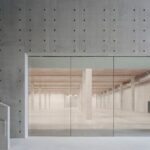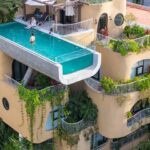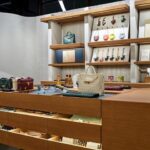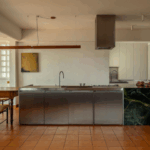Solid Surface Solutions
When it comes to which materials to use for your kitchen, bathroom or laundry surfaces, today’s renovators are spoiled for choice.
Choosing hardy surfaces for your kitchen, bathroom or laundry benchtops and splashbacks translates into a solid investment in your home. Taking the brunt of everyday living, your surfaces need to be durable and functional, while also standing the test of time.

GALLERY
As the surfaces upon which you prepare meals for your family, entertain guests, work from home or carry out myriad household chores like washing, your materials need to be tough, look good and be easy to maintain.
With a list of options that include granite, solid surfaces, quartz, porcelain and laminate, your surface choices in today’s market are extensive, so it pays to do your research ahead of time. From personal aesthetics to cost factors and practical considerations, knowing what you’re getting with each surface helps you find value for money to suit your individual needs.
NATURE’S NIFTIEST
When it comes to natural beauty, you can’t beat the unique countenance of Mother Nature. Choosing a natural stone such as granite, marble, quartzite or dolomite for your countertop or splashback offers a uniquely varied appearance that can add true character to a room. The range of patterns and colours available means you can find something truly individual that reflects your own personal design style.
Highly durable, natural stone will often withstand heavy use with little to no signs of ageing. A bundle of functional benefits like scratch- and heat-resistance makes it a versatile option ideal for heavily trafficked areas such as kitchens and bathrooms.
Natural materials can also be considered a more environmentally friendly choice than synthetic materials, since they are sourced from the earth and are biodegradable. Additionally, some natural materials are recyclable and can be repurposed for other uses once they have reached the end of their lifecycle.
While there are several benefits to be had with choosing natural stone, there are a few drawbacks. Some materials, such as marble, can be softer and therefore require more care. The porosity of these types of stone means they are not always stainproof and will need regular sealing to protect them. Repairing natural stone is also not as easy as manmade surfaces and can be costly to install.

GRANITE
Granite is a natural stone that is quarried from the earth’s crust. It is one of the most popular surface materials for kitchens and bathrooms due to its durability, resistance to heat and timeless beauty. Granite is available in a wide range of colours and patterns, making it a versatile choice for any style of kitchen, bathroom or laundry.
PROS
- Extremely durable and resistant to scratches, chips and cracks
- Heat resistant, making it ideal for use in the kitchen
- Natural variations that provide a unique aesthetic
- Resistant to bacteria and other harmful microbes
- Requires little maintenance beyond regular cleaning
CONS
- Expensive compared to some other solid surfaces
- Can be porous if not sealed properly, which can lead to staining
- Heavy and difficult to install
- May require periodic resealing to maintain its appearance and durability
MANMADE MARVELS
Like natural stone, there are many benefits to choosing manmade or engineered surfaces for kitchens, bathrooms and laundries. First and foremost, they are extremely strong and durable, making them resistant to scratches, chips and cracks. They are also non-porous, meaning they are resistant to stains, bacteria and other harmful microbes. This makes them a great choice for both kitchens and bathrooms, where spills and messes are common.
Additionally, due to modern technology and manufacturing processes, manmade or engineered surfaces offer a wide range of colour options and patterns. This allows homeowners to choose a surface that complements their aesthetic preferences.
Finally, manmade or engineered solid surfaces are often more affordable. There are several types of solid surface materials, each with their own features and benefits. The most commonly known products include quartz, solid surfaces, porcelain and laminate.

QUARTZ
Quartz, also known as engineered stone, is a popular choice for solid surface materials due to its durability and non-porous surface. Significantly stronger than natural stone, it is composed of natural quartz minerals and resin binders, resulting in a material that is extremely strong and durable. Quartz is available in a wide range of colours and patterns, making it an ideal choice to complement any design style.
PROS
- Extremely durable and resistant to scratches, chips and cracks
- Non-porous, making it resistant to stains and bacteria
- Available in a very wide range of colours and patterns
- Requires little maintenance beyond regular cleaning
- Suitable for countertops and splashbacks
CONS
- More expensive than some other solid surfaces
- Not as heat resistant as granite, so caution should be used with hot pots and pans
- Can discolour or fade with prolonged exposure to direct sunlight
- Some quartz may require periodic resealing to maintain its appearance
SOLID SURFACES
Solid surfaces are manmade materials that are used in a variety of applications within the home. These materials are made by combining natural minerals, such as quartz or granite, with synthetic materials, such as acrylic resins or polyester resins. The resulting material is then shaped and moulded to form the required product.
Non-porous solid surface materials are known for their durability and versatility. They have a uniform appearance and are available in a wide range of colours and patterns. They are also easy to clean and maintain, making them a popular choice for both residential and commercial applications.
Due to their generic descriptor, understanding the term “solid surfaces” can be confusing. Solid surfaces are differentiated by brand name, such as Caesarstone, Silestone, Corian or Staron. Each brand is usually a trademark and has its own proprietary mix and style offerings.
PROS
- Versatile, durable and non-porous
- Resistant to scratches, stains and heat damage
- Available in a wide range of colours and patterns
- Manufactured to provide a seamless appearance with no visible joins or seams
- Can be repaired if scratched or chipped
- Non-porous surface makes it easy to clean and hygienic
CONS
- Not completely impervious to damage, can be chipped or cracked by heavy impacts or sharp objects
- Can be sensitive to heat damage if exposed to high temperatures from pots and pans placed directly on the surface
- More costly than some materials such as laminate and tile
- Vulnerable to strong chemicals, such as nail polish remover or caustic cleaning materials

PORCELAIN
Porcelain is a manmade solid surface material composed of a combination of clay, feldspar and other natural minerals. It is becoming an increasingly popular choice for both kitchens and bathrooms due to its durability and easy-to-maintain surface.
Porcelain is extremely durable and can resist heat, scratches, chips and cracks. It is non-porous so is resistant to stains and bacteria, making it an hygienic choice. It also requires little to no ongoing maintenance and is easy to clean with non-caustic cleaning products.
As a sintered product, porcelain is close to being indestructible. Sintering, a heat treatment process that combines high temperatures and pressure to compact materials into a solid piece, makes porcelain slabs extremely dense. The product’s low porosity makes it valuable in wet room areas such as kitchens and bathrooms, where stain resistance and hygiene are a priority.
PROS
- High resistance to UV light, making it suitable for indoor and outdoor use
- Available in a range of colours, patterns and finishes
- Heat and scratch resistant
- Highly strong, durable and versatile
- Ideal for cladding, flooring and benchtop applications
- Available in varying thicknesses
- Easy to clean and doesn’t require sealing
CONS
- Can be more expensive that other engineered products
- Not as heat resistant as natural stone
- Thicker slabs can be heavy, making them a challenge to install
- Requires an experienced fabricator to handle it, adding to cost
- Patterns are only surface printed
- Can have visible seams and joints

LAMINATE
Laminate is a popular alternative to stone due to its cost effectiveness and endless variety. Made of materials such as MDF board, plywood or chipboard, laminate can be made to look like natural materials such as timber and stone.
Laminate is water resistant, but is prone to scratching and denting and can be damaged by extreme heat. While it is available in an extensive choice of unlimited colours and patterns, the product has a finite lifespan of approximately 20 years. However, the cost-effective nature of laminate does make it a good choice for investment properties and commercial ventures that are likely to undergo updates or renovations within a shorter period of time.
PROS
- Highly affordable
- Available in a wide variety of colours, patterns and textures
- Easy to clean, requiring only a damp cloth and mild detergent
- Resistant to most stains and spills
- A durable material that can withstand regular use without showing signs of wear and tear
CONS
- Can be damaged by heat, so hot pans or dishes should not be placed directly on the surface
- Not as scratch resistant as other materials such as granite or quartz
- Can be damaged by prolonged exposure to water
- Cannot be repaired if damaged and may need to be replaced
- Edges can be susceptible to chipping
SOLID SURFACE MANUFACTURING
While concerns have recently been raised regarding engineered stone products and the hazards they present for those who work with these materials, many leading manufacturers have already taken steps to ensure the protection of their workforce.
WHAT IS SILICA?
Silica is a common mineral found in rocks, sand and soil. When these materials are cut, drilled or otherwise disturbed, fine particles of silica dust can be released into the air. When workers inhale these particles, they can become trapped in the lungs, causing damage and scarring that can lead to a diagnosis of silicosis.
Silicosis is most commonly associated with long-term workers exposed to dust particles as a result of their occupation, such as those in the construction, mining and manufacturing industries. Preventing silicosis involves reducing exposure to silica dust in the workplace. This can be done by using engineering controls, such as ventilation systems and wet cutting methods, to minimise dust exposure. Personal protective equipment, such as respirators, can also be used to protect workers from inhaling silica dust.
CLEANING UP THE INDUSTRY
One company committed to reducing the hazards of working with silica is Cosentino, which manufactures solid surface brands Silestone® and Dekton. A world leader in the manufacture of luxury mineral surface products, Cosentino is ahead of the game when it comes to transforming the manufacturing of engineered surfaces.
Over the last 10 years, Cosentino has undertaken comprehensive research and development programs to substantially reduce the crystalline silica content of its Silestone® products to limit exposure to respirable crystalline silica.
Engineered stone products originally contained up to 95 per cent silica, however Cosentino’s market-leading Silestone® Q10 and Q40 products contain less than 10 per cent and 40 per cent crystalline silica respectively.
Providing a low-silica product that can deliver high performance and durability has been at the core of Cosentino’s development work. Utilising a sustainable manufacturing process that uses 99 per cent reused water, 100 per cent renewable energy and zero waste water, Cosentino’s HybriQ Technology® is employed across its entire Silestone® range.
Empathetic to the health and safety concerns around engineered stone, Cosentino has also been working tirelessly to help educate the industry in best safety practices. Cosentino’s Vice President Oceania, Itay Shimony, says, “We support the development of a nationally coordinated approach focused on the elimination (so far as is reasonably practicable) of health and safety risks associated with high-risk crystalline silica work. Providing a low-silica alternative that continues to deliver high performance and durability is at the heart of Cosentino’s entire range, providing Australian consumers with an ethically positive choice.”
Powerhouse Castle Hill has emerged as a vital hub for the Powerhouse Collection, supporting research, conservation, and public ...
Construction is set to begin on a six-storey office development in Canberra’s tightly held Barton precinct, as ACT-based ...
Ho Khue Architects has completed Saha Casa Boutique, a sculptural five-storey hotel in Da Nang that reinterprets the ...
Luxury fashion house Bottega Veneta has opened a striking new pop-up at London’s Harrods, where modernist architectural influences ...
Located in the bohemian inspired neighbourhood, know for it's fashion stores, casual cafes and contemporary art galleries. This ...













